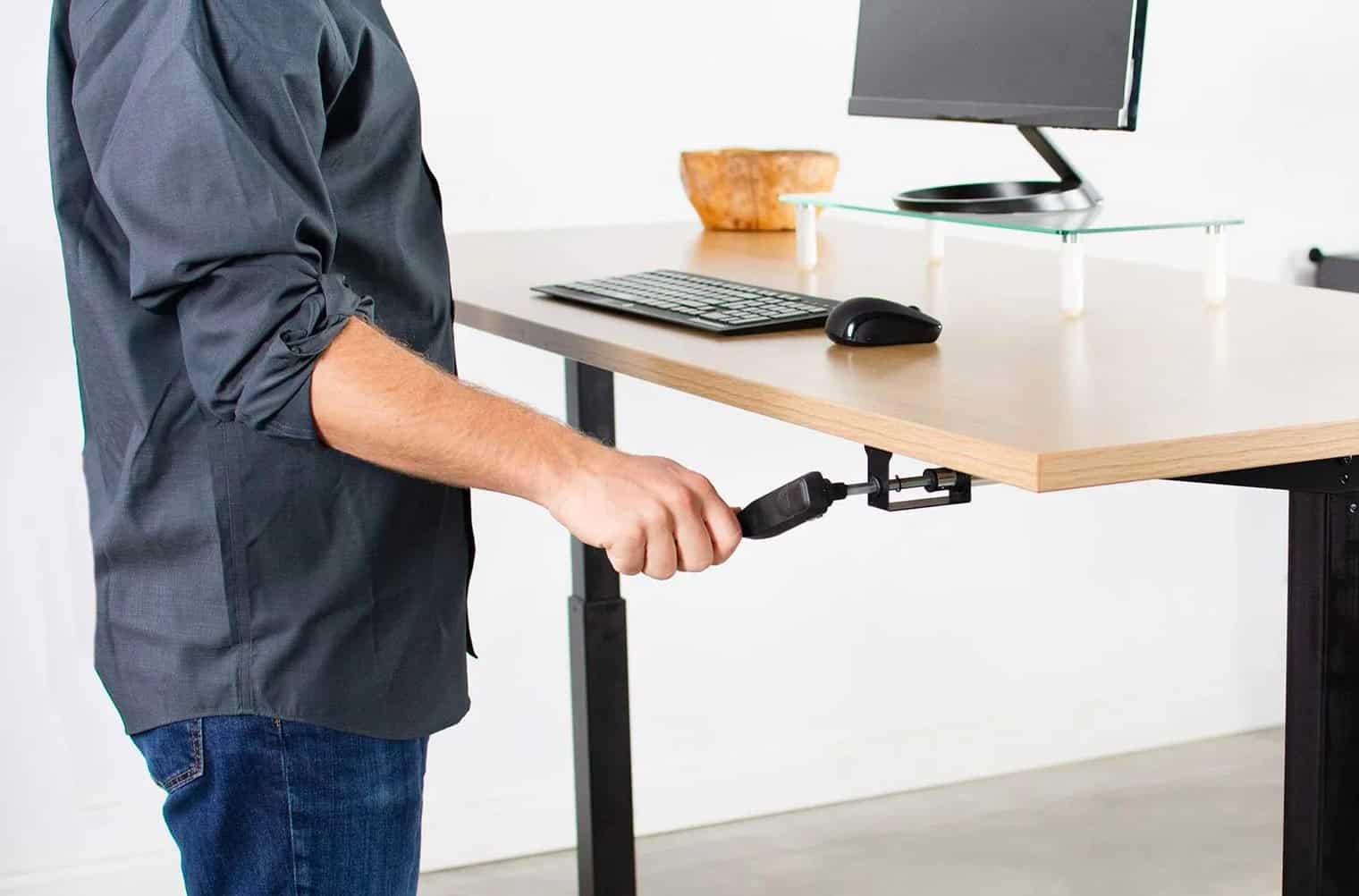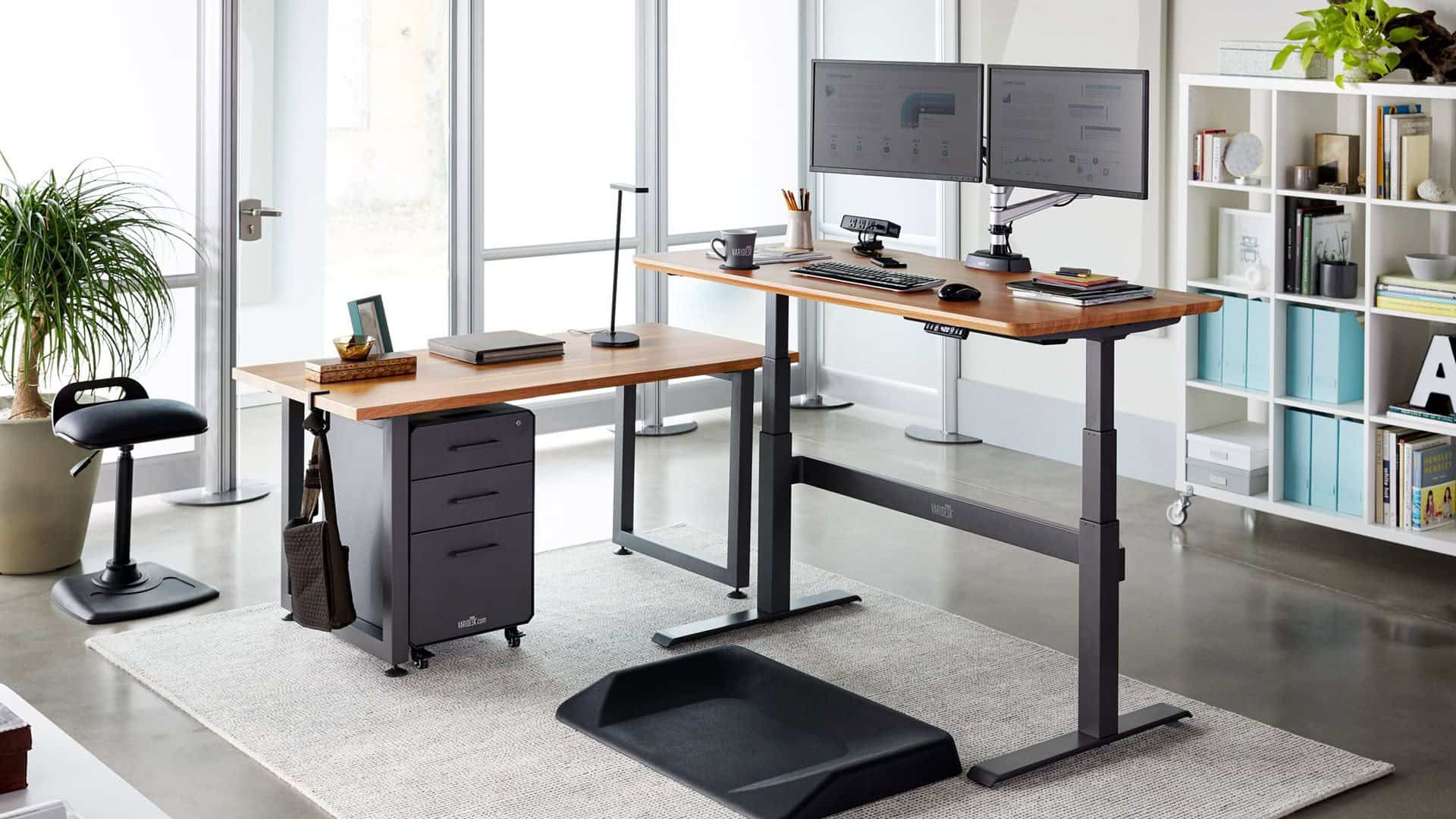Table of Contents
Standing desks have surged in popularity due to their potential health benefits, such as reducing the risks associated with prolonged sitting. If you’re an office worker in the market for a new standing desk, you’ll likely face the decision between a manual (hand-cranked) or electric (automated) model. Each height-adjustable desk type has its pros and cons, and the best choice depends on your needs, preferences, and budget.
To find out which one is the clear winner in the electric vs manual standing desk discussion and to help you make an informed decision, here’s an article comparing the benefits and drawbacks of an electric vs manual standing desk.
What Are the Differences Between Automatic Sit-Stand and Manual Standing Desks?

When comparing manual and automatic sit-stand desks, it’s essential to understand the notable differences that set these two types apart. Below are the key distinctions between electric standing desks and manual standing desks:
Adjustment Mechanism
Both desks have a similar structure but the main difference between a manual standing desk and an electric desk lies in their height adjustment mechanism.
Manual standing desks are also referred to as hand-crank standing desks because they use a hand crank that requires more physical effort to raise or lower the desk. The hand crank mechanism is straightforward, but it can be time-consuming, especially if you frequently switch between sitting and standing positions. Weak people may also struggle with this kind of desk.
In contrast, an electric standing desk or an automatic desk makes use of electrical power to operate. With just the press of a button, you can adjust an electric desk’s height smoothly and quickly. Many also offer programmable presets, allowing you to save your preferred heights for added convenience. For many, an electric adjustable desk is the superior choice for this reason alone.
Ease of Use
Manual standing desks, while reliable, demand a certain level of manual effort each time you need to change the height. This can become inconvenient if you need to make adjustments throughout the day. The visible hand crank may also require several turns to reach the desired height, which can be physically demanding, especially for larger desks.
On the other hand, like all things automatic, the electric version of a standing desk shines in terms of ease of use. The motorized adjustment system requires no physical effort, making it ideal for people who need to transition between a sitting and standing position frequently. The simple push-button operation makes an electric desk accessible to all users, regardless of physical ability.
Cost
Cost is another major difference between electric vs manual standing desks. A manual standing desk is generally the more affordable option due to its simpler design and there’s no electricity required to operate it. For budget-conscious buyers or those who prioritize function over luxury, a manual one is a good option.
Electric standing desks, on the other hand, tend to be more expensive. The additional cost covers the motorized components, preset features, and often a more sophisticated design. However, the convenience and ergonomic benefits they offer can justify the higher price tag for many users.
Maintenance and Durability
When it comes to maintenance, desks with a manual frame typically require less attention. Their simpler mechanical design means fewer components that can break or malfunction. As long as the hand crank is in good working order, a manual standing desk can last for many years with minimal upkeep.
Electric standing desks, however, have more complex systems. The motors and electronic controls can experience wear and tear over time, potentially requiring repairs or replacements. An automatic adjustable height desk can also be more expensive to maintain because of its motor drive. While many electric desks come with warranties, it’s essential to consider the potential long-term maintenance costs.
Noise Levels
Noise is another factor that distinguishes manual from electric standing desks. An electric desk can produce noise when the motors are in operation. While most modern electric desks are designed to operate quietly, the noise level can vary depending on the quality of the motor and the desk’s design. If you work in a shared or quiet environment, this could be a consideration.
Compared to their electric counterparts, a hand-crank standing desk is generally quieter since it relies on the crank mechanism rather than a motor. You may hear some noise from the gears as you adjust the desk, but it’s usually minimal.
Weight Capacity
Manual standing desks often have a higher weight capacity compared to electric desks. This is because they don’t rely on motors to lift the load, which can be a limiting factor in electric models. If you plan to place heavy equipment on your desk, such as multiple monitors or desktop computers, a manual desk might be more suitable.
Electric desks, while still capable of handling a substantial load, may have lower weight limits due to the strain on the motors. Always check the weight capacity of an electric desk to ensure it meets your needs.
Is a Pneumatic Desk a Type of Manual Standing Desk?
Yes, a pneumatic standing desk is considered a type of manual standing desk. While it provides easier height adjustment compared to a traditional hand-crank desk, it still requires manual effort to raise or lower the desk using a gas cylinder mechanism, without the need for electricity or motors. This places pneumatic desks in the manual standing desk category, despite their smoother adjustment process.
Electric vs Manual Standing Desk: Which Is Better?

The electric vs manual standing desk debate is always a heated one, and while both are excellent in their own right, there is almost always no clear winner in the end. This is because choosing between a manual or electric standing desk depends on several factors, including your budget, how often you plan to adjust the desk height, and your workspace setup.
Manual standing desks, also referred to as hand-crank standing desks, tend to be more affordable and are an excellent option if you don’t need to frequently change your desk height. If you prefer simplicity and don’t mind using extra power, a manual desk could be the better choice. If you want to engage in active living, you should opt for a hand-crank desk.
Electric standing desks are ideal for those who need to adjust their desk height multiple times throughout the day. They’re particularly useful in a shared office environment where different office workers might have varying height preferences. The convenience of adjusting the desk with a button press can save time and reduce strain, making electric desks a better option for those with specific ergonomic needs.
Do Electric Standing Desks Last?

One of the concerns with electric standing desks is their longevity. Since they involve motors and electronic components, potential buyers often wonder if they will hold up over time. Generally, high-quality electric standing desks are built to last, with many manufacturers offering warranties that cover several years of use.
However, like any electronic device, electric desks can experience wear and tear, particularly in the motors. Many electric desks tend to only have a lifespan of 5 years, or up to 10 years if it’s a premium one. Regular maintenance, such as ensuring the desk is not overloaded beyond its weight capacity, can help extend its lifespan. If longevity is your top priority, choosing a reputable electric desk brand with a strong warranty can provide peace of mind.
Is an Electric Sit-Stand Desk Worth It?

The decision to invest in an electric adjustable desk boils down to whether the benefits outweigh the cost. Electric standing desks are typically more expensive than their manual counterparts, but they offer significant advantages in terms of convenience, ergonomics, and user experience.
For those who value ease of use, have specific height preferences, or share their desk with others, an electric standing desk is worth the investment. The ability to quickly switch between sitting and standing positions can enhance productivity, reduce discomfort, and promote a healthier work environment.
In contrast, if you’re on a tight budget or don’t require frequent height adjustments, a manual desk can provide a cost-effective solution without sacrificing the core benefits of a standing desk. If you want to reduce your electrical waste, manual desks are the ones for you. Additionally, manual desks are the better choice if your workstation isn’t near any power outlets or if you don’t mind exerting more effort to adjust the height of your desk.
Final Note
Using a standing desk will reap a ton of health benefits such as better posture, reduced pain, increased blood flow, enhanced energy, and more productivity. Both manual and electric standing desks work well with any ergonomic chair and have their merits, but they also have notable differences worth pointing out.
Ultimately, the best option depends on your personal preference, individual needs, aesthetic appeal, circumstances, workspace requirements, and other miscellaneous buyer factors.
Manual desks are budget-friendly and reliable, while electric desks offer unmatched convenience and flexibility. By considering factors such as frequency of use, budget, and workspace needs, you can choose the height-adjustable desk that will best support your health and productivity goals.
